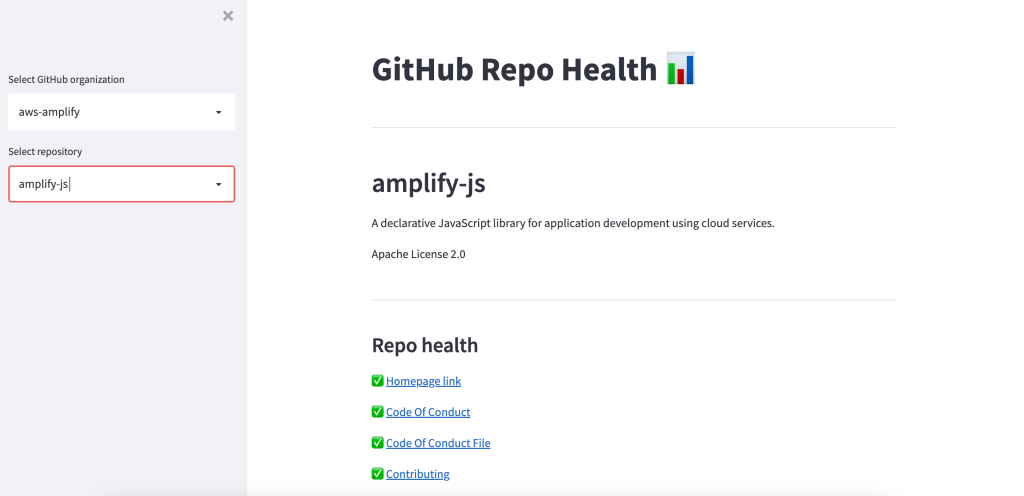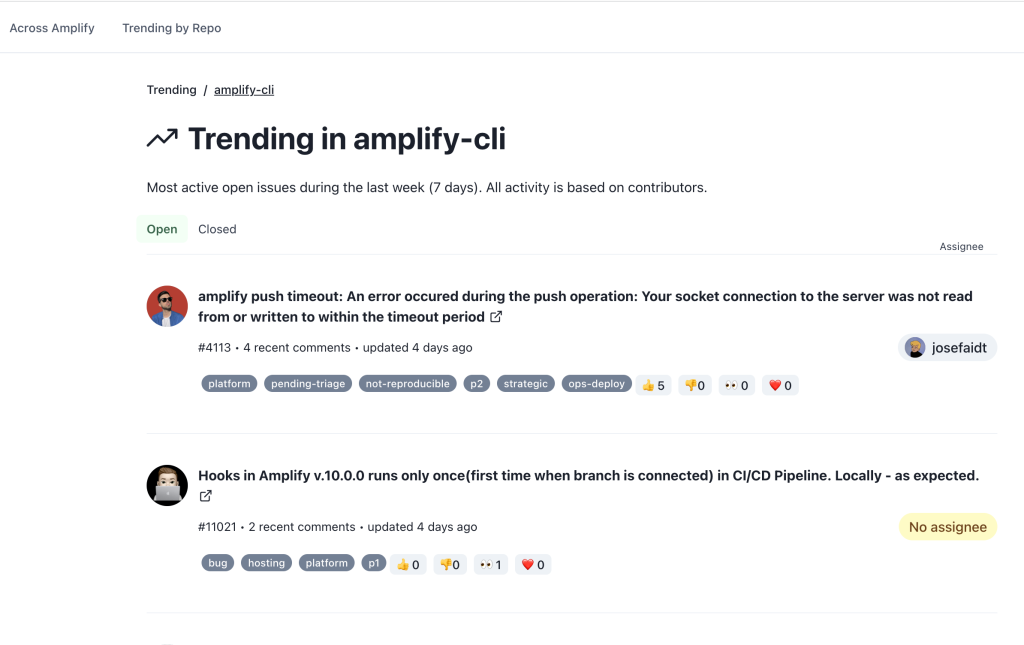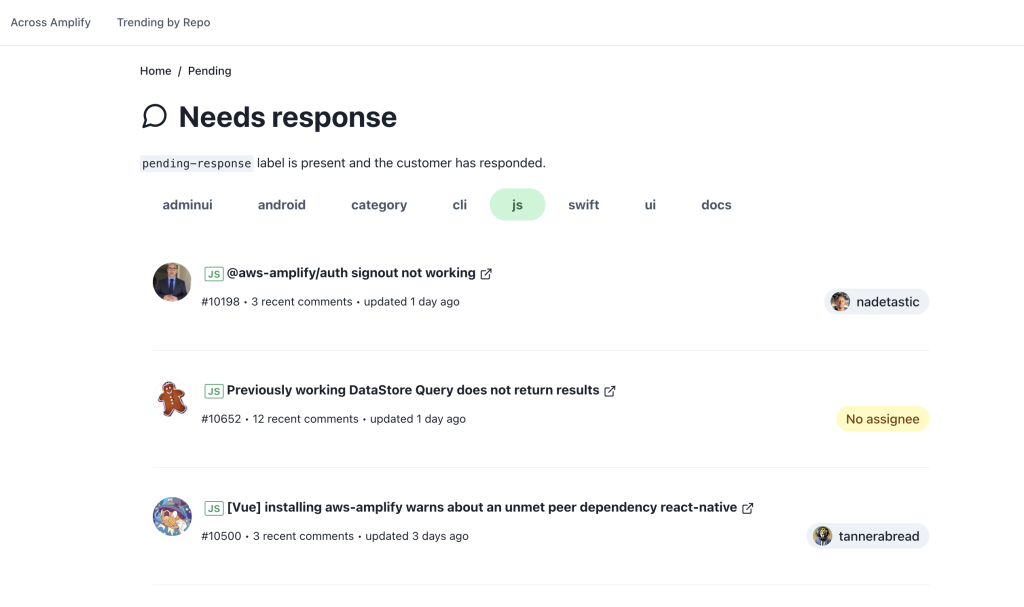AWS Open Source Blog
Driving Action and Communication in AWS Amplify Open Source Projects
AWS Amplify is a complete solution that lets frontend web and mobile developers easily build, ship, and host full-stack applications on AWS, with the flexibility to leverage additional AWS services as use cases evolve. To build Amplify applications, customers typically use one of the open source Amplify libraries. At Amplify, we manage and build these open source projects on GitHub.
In the last year, the number of contributions across the Amplify projects has increased and the teams have scaled to meet customer needs while building across programming languages and frameworks. This necessitates a constant balance of collaboration with contributors and also flexible processes to continually move the projects forward. The goal is to provide a delightful experience for Front End developers building on AWS.
Open source is as much about relationships as it is about code. These relationships are being built anytime the team is collaborating with external contributors, developers, and customers at different touch points. A core element to facilitate open source is to facilitate relationships through consistent and transparent communication. There isn’t a clear, well-defined playbook for this. It requires iteration and continuous feedback from contributors to fine tune and make better. How we communicate can mean how the projects are planned, structured, and received by the developer community! And all of this may change over time!
In this post, we’ll cover some processes and tools that we’ve built and use at AWS Amplify to help build a vibrant and responsive open source community.
Organization
For context, an average of 35 external contributor pull requests (PRs) and 350 issues are opened each month on GitHub across the Amplify project repositories. In 2022, this equated to an 80% increase in issues and 66% increase in external contributor PRs from the previous year. An external contributor is any active contributor that is not a member of the Amplify GitHub organization. These projects range from the Amplify CLI to the client libraries like Amplify JS and Amplify UI. We also have a very active Discord server with over 19,000 members.
Along with the growth, it can be a cultural shift for both AWS engineers and customers to work in the open. Not every team member is used to working in public, and not all customers are used to working with AWS through GitHub or Discord.
Our ownership model is that each individual team manages their own repositories and is responsible for the project health and operations. This includes issue and Pull Request (PR) management, communication, and releases. This level of autonomy helps the projects move fast and remain flexible. As the service has grown, so has the need for standardization and operational tooling within each team.
Communication and transparency – reducing the time to response
The starting point for community is consistent communication and transparency. There are different elements to this and it fluctuates over time and as projects grow or slow in velocity. There is an expectation in open source software development that there is an ongoing dialog with the community. This may take the form of contributors helping on issue triage and workarounds, providing feedback on Request for Comments (RFCs), and submitting PRs. It could also be developers using the libraries and services within their applications.
In each of these scenarios, open communication is what helps to oil that machine. In open source, the goal is to determine an action for each issue, pull request, feature request, or question that is created. In most cases, proactive communication and quick responses in issues and PRs helps to determine this action faster. This also shapes the open source contributor experience. An external contributor is more likely to stay engaged in an issue thread or PR review if the maintainers are quick to respond.
Knowing this, we identified ways to reduce friction and make the experience better knowing that communication plays such a large role. These ways are:
- Standardize the structure of the operational processes (GitHub issues labels, etc.)
- Communicate as early and often as possible in response to open items (issues, PRs, etc.)
- Proactively track updates on these items in order to follow up quickly
With these goals in mind, we had to operationalize processes to allow us to deliver on each. Thinking through this, two core themes surfaced:
- Develop a consistent approach and cadence for communication
- Reduce overall time-to-response (or action)
Tackling these first would improve the contributor experience and begin to strengthen our own internal culture. Once standardized, we could then proactively track open items and metrics.
Communications processes
How do we improve communication across our project? This is where that cultural shift comes in. Sometimes this requires changes to normal process and team communication to fully embrace working in the open. The project is always evolving and updating, including nights and weekends. Without a clear process to drive action, things can quickly begin to get missed.
The first task was to find the root cause of the communication friction points in a project repository. What are the communication touch points? At those points, where can automation help reduce friction and time to next action? The initial entry points to communication in a GitHub repository are:
- A contributor is using the project and opens an item in the form of an issue, or
- A contributor opens a PR to submit code for inclusion into the project
The team on-call engineers were initially shadowed to observe how they identified, and interacted with, new and updated issues and PRs. A common theme was that the context switching and frequent back and forth on these items was very time consuming and hard to track. After observing this same pattern across multiple projects, it was clear that the conversation should be streamlined.
We needed an efficient way to both remind the original posters of what is needed to help reproduce an issue and encourage them to also provide details. For each of these items, we had to determine the best way to expedite the path to action. Maintainers need to triage an issue to determine the next action to take. Maintainers also need to triage each pull request to determine if it aligns with the project and identify what the next steps are with respect to review and merge.
GitHub issue template forms to the rescue
We initially standardized the GitHub issue template forms across all of the Amplify projects after getting access to the Beta feature in early 2021. These forms are used each time a contributor opens an issue, pull request, or feature request in a repository. This allowed for more actionable conversations by collecting all of the required information up front. The goal of the form was to collect just the required information without introducing unnecessary friction for contributors. This is different from the original GitHub issue templates that allowed for more free-form data entry. With this approach, we were able to require standard information that had been found to be helpful in triaging issues while shadowing the maintainers. Here is a screenshot of a portion of the current GitHub issue form template in the Amplify CLI repository.
 This is the form that is used to open new issues in the repository. It asks the user to check some boxes before opening an issue, such as whether they have installed the latest version of the Amplify CLI, searched for duplicate or closed issues, and read the guide for submitting bug reports. It also asks some open ended questions about the user’s environment.
This is the form that is used to open new issues in the repository. It asks the user to check some boxes before opening an issue, such as whether they have installed the latest version of the Amplify CLI, searched for duplicate or closed issues, and read the guide for submitting bug reports. It also asks some open ended questions about the user’s environment.
As using the new form to file an issue became the standard, the starting point for communication became clearer, allowing future interactions on issues and PRs to be more direct. Through the structured nature and standardized collection of data fields, we were able to significantly improve the quality of our search results. This has helped to reduce duplicate issues (although they may still exist in some forms in older issues) and increase visibility and traction on current open issues and feature requests.
Standardization
As the Amplify project quickly grew, the operational processes needed to grow with it and remain consistent across teams. Repository standardization tools are typically templates used to structure a project when it is first created. The original templates are helpful but there is an ongoing challenge of maintaining, or changing, the structure over time as these dimensions change. To account for this, we created an open source repository audit tool that provides a declarative approach to keep certain items such as labels, project topic tags, and descriptions up to date.
The audit tool also includes a dashboard to provide insight into other items, such as GitHub actions, required links, and the number of good first issues. The required items are defined in a configuration file and each repository is checked against that structure. This is a simple but effective way to quickly check across all the projects without manually checking each project.
Repositories will change over time but we need to make sure that there is consistency in the core structure. For instance, new labels are added, some are removed. Or, the CODEOWNERs.md file needs updated. The audit tool queries the repository metadata and provides a self-service way for each team to check if the repo is in good standing as part of their standard operating processes or has fallen out of date and needs attention. This screenshot shows a portion of the audit tool for the Amplify JS repository. The green check mark next to the links indicates that these items are present in the repository.

We want customers to have a consistent entry point when landing in any AWS Amplify repository. This includes the same nomenclature and core labels to correctly communicate the lifecycle of issues and PRs. This screenshot shows the required labels section of the tool. The set of required labels is compared against the labels in the repository for any discrepancies.

Data and tooling – separating out external contributor events
To accurately gauge activities on issues and opened items, it was critical to determine whether events were initiated by someone on the Amplify team or an external contributor in order prioritize communication and the triaging process. Our triaging process involves troubleshooting or reproducing an issue by a project maintainer. We needed to isolate GitHub issue (and pull request) event data created by external contributors in a separate tool to support this effort.
To track this event stream from GitHub, we built serverless data processes using AWS Lambda to capture issues and PRs that have been updated, and then capture any new events (comments, labels, etc.) on the issues. The data allows for ad-hoc querying against events to isolate if activity is increasing in a certain area. This also helps teams to quickly spot items when there are lags in timezones or as team on-call rotations change. All of these queries take into account the active members of the Amplify organization to identify those events only triggered by external contributors.
Capturing this data has allowed us to build tools to proactively engage in open and closed issues. The following sections outline these tools.
Trending issues
With the external contributor data separated from Amplify team events, we are able to start tracking, in near real-time, issues that have an increased amount of activity within a given time period. One way has been to create a dashboard that highlights trending issues that are receiving increased activity from external contributors. This is used at the individual project level and also across all of the projects. This helps to identify cross-project themes that may be starting without constant, manual, checking of issues to see what has changed.
The trending dashboard only ranks issues based on the activity that they are receiving from external contributors within a given time period. It takes into account recent comments and the aggregate reactions on comments that are not created by Amplify maintainers. This provides a holistic view to the themes that contributors and developers may be experiencing across the entirety of Amplify without the noise of Amplify team comments.
This includes issues, both open and closed post triage when there’s already been communication. It’s important to track closed issues (that are not locked) to not miss any new comments or activity. Since the issue is closed, those comments may not be seen unless a team member happens to view the issue. This screenshot shows the trending list of open issues in the Amplify CLI repository. The list of issues and aggregated metadata (number of comments and reactions) only includes data from external contributors.

Closed issues with increased activity
As previously mentioned, closed issue visibility is a challenge since it’s difficult to track which closed issues were updated and their specific changes – new comment, increase in number of reactions. The trending dashboard also tracks this activity.
The dashboard is especially useful for issues that are already closed that may continue to receive events. Without automation, it’s very time consuming (and manual) to identify an increased spike in reactions or external contributor comments on issues across one project, let alone over 20. Often times in projects, these comments go unnoticed unless an Amplify team member is tagged or subscribed to a specific item and happens to see the notification.
Having a UI that highlights these items also helps to reduce notification fatigue. The Amplify team (engineers, product, and developer experience) receive many notifications across items for many of the Amplify repositories. It is helpful to have a single dashboard to spot check if activity has increased on an older, closed issue.
Metrics to track
So how do we know that all of these processes and tools are making a positive impact? A few key metrics helped:
Mean Time to Respond (MTTR) – This measures how responsive we are to customers and encourages communicating as soon as possible once an issue or Pull Request is opened.
Mean Time to Close (MTTC) – This measures the overall timeframe that it takes to close an issue or Pull Request.
The definition of these metrics used with the constant stream of event data has allowed us to track the MTTC and MTTR of items at the repository and organization level.
MTTR is primarily about response times. How quickly do we respond back throughout the lifecycle of an issue (or PR)? A lower MTTC indicates that issues are closed faster. This may mean a few things: Maintainers have answered questions, reproduced issues, and actioned PRs. There are a lot of factors that contribute to an item being closed, which may have varying timelines. One example is feature requests that may remain open longer than a normal issue. There are caveats to each metric, but this helps to isolate issues that need further investigation.
Even with the progress in tracking, a few consistent challenges presented themselves. The back and forth communication on issues can be very sporadic. The next step was to isolate which issues and PRs needed a response.
Pending response
It’s difficult and time consuming to keep track of comment responses in issues and PRs utilizing only the notifications view within GitHub. One mechanism to keep track of this is identifying items that were awaiting a response and the original poster has now followed up (i.e. responded).
The ideal flow is something like this:
- Issue is opened
- Team responds with follow up or questions
- Issue is labeled pending-response
- A dashboard displays issues that have the pending-response labels AND an external contributor has responded
This helps reduce active response times and highlights when issues have received a reply. Additionally, this ensures that issues are actioned and don’t remain in an unknown state (i.e. not triaged) while awaiting a reply. Similar to the trending issues above, the team created a dashboard to surface any issue that fit this criteria. This screenshot shows the list of issues that need a response from the maintainers. These issues all have the pending-response label and an external contributor has been the most recent to comment.

Conclusion
Open source is not static. Tools, teams, and community are always evolving and what is working today will certainly change over the next year. Working backwards from consistency and communication has allowed Amplify to focus attention on prioritizing proactive action to make it a pleasant experience for community members to contribute to the projects.
We continue to identify more efficient ways to strengthen the developer relationships and facilitate more open communication across the Amplify repositories. As the community and project evolve, it’s important to remain flexible, communicate early and often, and continue to improve what the team can control.
Interested in learning more about open source at AWS Amplify? Follow @AWSAmplify on Twitter to get the latest updates about the Amplify Contributor Program, explore the open source Amplify GitHub repositories, or join the Amplify Discord server.